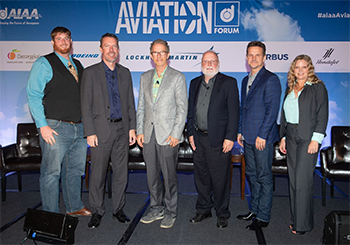How to Speed to Prototype Written 25 June 2018
Panelists: Moderator Starr Ginn, deputy aeronautics research director, NASA’s Armstrong Flight Research Center; Charles “Chase” Ashton, senior engineer, AeroVironment Inc.; Scott Drennan, director of innovation, Bell; Steve Ericson, director of advanced design, The Spaceship Co.; Bob Morgan, director of research and development, Scaled Composites; Michael Swanson, chief engineer, Advanced Development Programs, Lockheed Martin
by Michele McDonald, AIAA Communications Manager

AIAA AVIATION Forum, Atlanta, June 25, 2018 – Moving quickly from aerospace design to prototype can be daunting, but a few key principles may help: keep it simple; fail early and often; use existing technology; and perhaps most essential, have a great team.
A panel of aerospace experts outlined some key factors for a successful and fast prototype launch June 25 during the “Rapid Spiral Development From Ground to Flight” session at the 2018 AIAA AVIATION Forum in Atlanta.
Scott Drennan, director of innovation at Bell, said there’s a lot to learn from getting your hands on hardware because it feeds back into the design.
“I’m a big believer in the build,” he said.
Charles “Chase” Ashton, an aeromechanical engineer with AeroVironment Inc., said team members with many hands-on skills and who are “masters of some” are crucial to the success of a fast-moving project.
“We not only design [the prototypes] and build them, but have the ability to test them as well,” Ashton said.
Bob Morgan, director of research and development at Scaled Composites, said doing the work in-house, without relying upon contractors, helps speed the path to prototype; he advised not to design something you can’t build yourself.
Morgan added that companies should keep it simple and resist design changes late in the process because they add cost and time. Look at what really needs to be done and then add from there, he said, adding that the simplest answer can be surprising.
For example, Morgan said, a prototype aircraft with a pilot can be faster to prototype than an unmanned system, depending on the size of the aircraft.
“Sometimes it’s easier to stick a guy into it,” he said.
Another tenet: “Fail early and fail often,” Morgan said. Fixing problems early saves time and money.
In addition, reuse what you know, Michael Swanson, chief engineer of Advanced Development Programs at Lockheed Martin, said, adding that costs can be reduced by a factor of four by simply using existing parts and technology. Skunk Works tries to bite off only one miracle per aircraft program, Swanson joked.
Building trust with the customer also helps shave time from design to prototype, said Steve Ericson, director of advanced design with The Spaceship Co.
Embedding the customer within the team builds trust and speed, Ericson said. He explained that when he worked on a project that required nine prototypes built to production standards, the customer was a part of meetings and already knew about any failures and what was being done to fix them.
Keeping the customer close eliminates “having a Power Point battle,” Ericson said.
Panelists agreed that during this rapid process, both the team and the customer must have a high tolerance for risk and failure.
“It’s not for the faint of heart,” Swanson said.
